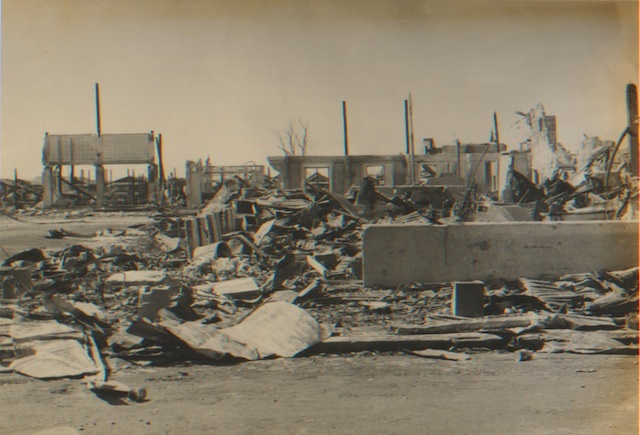
Above photo, from the OMI Archives, is from the Feb. 8, 2016 issue of Mindanews.
The devastation that happened forty-seven years ago hardly flickers in the memories of many Filipinos today. But, as always, there are carriers of memories sustained by time despite the pain and the agony of remembering.
Among these is the Burning of Jolo by the forces of dictator Ferdinand Marcos in the early years of martial law that, when juxtaposed to the present, posits parallels to the 2017 Marawi Siege.
My attention was called to a paper written by a young history instructor of University of the Philippines Visayas. Elgin Glenn R. Salomon used the framework of Michel Foucault in using testimonial narratives to “unravel the roles of identities and culture in the dynamics of conflict.” The author calls it a “counter-history.”
Why did the author believe the need for such an approach? First, he cites the problem of dichotomous sources – sources that are either for the state or for the Moro National Liberation Front. The result, he contends, is a story of “silenced narratives.” Where are the voices of the civilians? Then, he presents us with the problem of “monochromatic historiography” of the Marcos martial law, where government narratives were largely polarizing. For example, newspapers were controlled by the Marcos regime.
The writer’s aim then was to find the civilian survivors. He found 10. He then allowed them to articulate their reflections and the long-term impact on their lives. The author calls his knowledge production a “blueprint” of recording the narratives of those marginalized by war and by martial law.
The Burning of Jolo was presaged by the birth and growth of the MNLF that was influenced by multiple factors, among others: the Jabidah Massacre of March 1968 involving 28 Tausug trainees (16 are still missing until today); the student activism of the 1960s; and the popularity of Nasserite nationalism among young Moro intellectuals studying in Manila who had looked up to Gamal Abdel Nasser, the decolonizer revolutionary of Egypt. The MNLF was born on October 21, 1972, exactly a month after the declaration of martial law.
Militarization has always been the state’s response to secession. Is it really the right response? As the MNLF had grown in numbers and territories (it had by then gained adherents in mainland Mindanao), the military feared that civilians might extend assistance to the rebels. To prevent that, military forces patrolled Jolo heavily.
The next thing was to instill terror among the populace. Brutalization was not far behind.
One of the narrators recounted: “Many were picked up and disappeared. Then you will see them dead the following day. While others, you see them floating in the sea or they suddenly disappeared. Sadly we were living in fear.”
The MNLF decided on a strategic offensive: invade Jolo and meet the military head-on. The battle erupted on February 7, 1974 when state forces responded with air and naval bombings. The Air Force dropped napalm bombs to deliberately set the town on fire, the rationale being that if all the houses were gone, the rebels would have lost their hiding places. But always there is the ignored fate of the civilians. The carpet-bombing left two thirds of the town in ashes, 40,000 residents homeless, and more than 300 dead. It was a catastrophe of a grave humanitarian magnitude.
“To present the extent of damage on the 1974 Battle of Jolo, the New York Times compared the scene of devastation and ruin to what happened during World War II,” the author references.
Soldiers deployed from other places in the Philippines entered into the town’s dynamics as outsiders to patrol a Jolo that agonized over its destruction. Because no badge identifies one Tausug as MNLF, soldiers treated everyone with suspicion, further fanning the flames of civilian admiration for the MNLF.
In what was probably one of the first instances of red tagging by the Philippine government, Marcos painted the MNLF as “Maoists” rather than as Islamic militants. A new vocabulary to the Tausug language arose: Mawis, pidgin that civilians learned from the military patrols.
In truth, Nur Misuari at some point had shed off Marxism-Leninism-Maoism as incongruous to Tausug society, where alliances with traditional elders was the norm. Maoism never gained a foothold in the MNLF.
“They wanted to ensure the continuing support of Islamic countries like Malaysia and Libya through sponsoring weapons, medical supplies, and military training. Solving the dialectic between Islamic and Maoist ideologies, Misuari’s group argued that everything Mao proposed, the Prophet Mohammad had already suggested.” The author references Indian writer Thayll J. S George, who wrote about Misuari in “Revolt in Mindanao: The Rise of Islam in Philippine Politics.”
It’s history repeating itself. Look at the parallels: When the Siege of Marawi ended, government was silent about its reconstruction. We forget that, till today, there are Marawi residents who still live in makeshift camps. Soon, we will remember only the saccharine parts of the script: The Grand Mosque of Marawi will be rebuilt and we will say that there were no human rights violations committed against the M’ranao when, in truth, there were.
The more government represses, the more warm bodies join the cause of rebellion. We always – yes always – forget that any assault on a people is an assault against honor.
Ten testimonials are few for a counter-history. The topic is ripe for a more comprehensive expansion. But it is a meaningful start. The Filipino has this habitus of suppressing memories of past trauma. We should keep memories of human catastrophes alive in the public discourse.
The views in this column are those of the author and do not necessarily reflect the views of VERA Files.